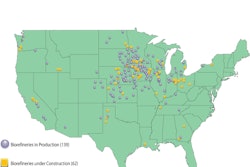The United States Department of Agriculture (USDA) projected in mid-June that U.S. 2008/09 corn production would be decreased 390 million bushels to 11.7 billion, with its next forecast due out in a week. The decline reflects lower expected yields due to slow planting progress, slow crop emergence, and persistent, heavy rainfall across the Corn Belt. Lower supplies are expected to boost prices and lower feed and residual use, exports, and ending stocks. World coarse grains production is expected to be down, with increased global production prospects offsetting about two-thirds of the U.S. drop. Because of increased worldwide beginning stocks, world coarse grains supplies for 2008/09 were up for June. In the U.S. at the end of June, three percent of the corn acreage was at or beyond the silking stage, up only 1 percentage point from the previous week. This was 8 points behind last year and 6 points behind the 5-year average. Development was 1 to 31 points behind normal in Illinois, Indiana, Kansas, Missouri, Nebraska, North Dakota, and Ohio. Major developmental delays continued in Missouri, where already saturated fields received additional rainfall during the week. In Tennessee, silking lagged the 5-year average pace by 31 points. Condition of the U.S. corn crop at the end of June was rated 61 percent good to excellent, an improvement of 2 percentage points from the previous week. Condition ratings improved across much of the Corn Belt as fields continued to dry out.
USA: Fields begin to dry out, but lower production expected
The United States Department of Agriculture (USDA) projected in mid-June that U.S. 2008/09 corn production would be decreased 390 million bushels to 11.7 billion
July 8, 2008

















